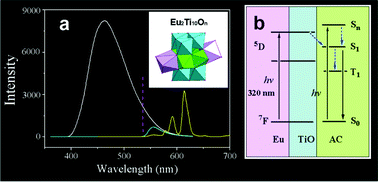Jie Dai*ab(戴洁)
a College of Chemistry, Chemical Engineering and Materials Science, Soochow University, Suzhou 215123, P. R. China
b State Key Laboratory of Coordination Chemistry, Nanjing University, Nanjing 210093, P. R. China
Dalton Trans. 2015, 44, 1882-1888
Two 9-anthracenecarboxylate (9-AC) coordinated heterometallic TOC compounds, [Ln2Ti10O14(ClO4)2(OiPr)14(9-AC)2(CH3CN)2]·2H2O, Ln = Nd(1) and Eu(2), along with two benzoate (bza) analogues, [Ln2Ti10O14(ClO4)2(OiPr)14(bza)2(HOiPr)2], Ln = Nd(3) and Eu(4), were prepared by one step in situ solvothermal synthesis, and characterized by single crystal analysis. To date, only about ten lanthanum-titanium oxo clusters have been reported. Except for two Ti28 clusters, the compounds are all small clusters (Ti ≤ 4). The cluster structures of 1–4 adopt a Ti10Ln2 core structure with pseudo-Ci symmetry, which is similar to the fundamental structure of Ti12 clusters. Furthermore, except for their structures, the properties of lanthanum-titanium oxo clusters have never been studied. Herein, the fluorescence properties of these compounds are studied in detail. The metal centered emission of Eu(III) is completely quenched by 9-AC due to the lower triplet energy of the coordinated ligand. Enhanced ligand centered fluorescence is found for 2 in comparison with that of 1.

链接:
//pubs.rsc.org/en/Content/ArticleLanding/2015/DT/C4DT02968B#!divAbstract